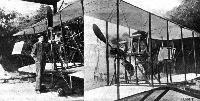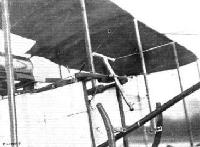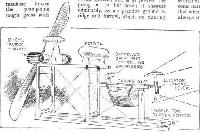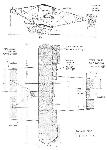P.Lewis British Aircraft 1809-1914 (Putnam)
Bland Mayfly
One of the earliest exponents of flying in Ireland was Miss Lilian E. Bland of Carnamoney, near Belfast, whose Mayfly of 1910 was the first biplane to be constructed in the country. After making many experiments and tests with large-scale model gliders, Miss Bland, assisted by S. Girvany of Ballymore, built the Mayfly early in 1910 first as a glider. The landing-wheels were omitted and the machine was tested by towing it off the ground on its skids to assess its stability and characteristics. The glider was launched also in free flight, and, upon being satisfied that the general design would be suitable for the installation of a power unit, Miss Bland proceeded to redesign the airframe to take an engine. Rounded wing-tips were introduced, ailerons were mounted on the outer pair of rear inter-plane struts and different tail units were tried out. This new version was also tested by towing before the undercarriage wheels and the two-cylinder horizontally-opposed 20 h.p. Avro engine and 6 ft. 6 ins. Avro propeller were fitted.
The airframe was constructed of wood with fabric covering, bamboo being employed for the outriggers carrying the front elevators and the tail unit at the rear.
The Mayfly was completed early in 1911, and Miss Bland started to teach herself to fly at Carnamoney. Her enterprise and resourcefulness were amply rewarded by the success of her creation, which flew quite well. Through the publicity given to her experiments, Miss Bland's courage and ingenuity came to the attention of a Canadian from Vancouver, whither she removed after her marriage to him at the end of 1911, thus bringing her flying to an end without gaining her Aviator's Certificate.
SPECIFICATION
Description: Single-seat pusher biplane. Wooden structure, fabric covered.
Manufacturer: Miss L. E. Bland, Carnamoney, Belfast.
Power Plant: 20 h.p. Avro.
Dimensions: Span, 27 ft. 7 ins. Length, 23 ft. Wing area, 250 sq. ft.
Weights: Empty, 200 lb. (glider).
Показать полностью
Журнал Flight
Flight, February 19, 1910
MISS LILIAN E. BLAND'S BIPLANE "MAYFLY."
I enclose two photos of my biplane, the "Mayfly." I made her entirely myself, with the exception of the metal clips, and, of course, the sockets, strainers, &c, were bought from English firms. I think she is the first biplane made in Ireland.
I had her out again to-day, wind of 18 m.p.h. My only difficulty is at present to prevent her flying when I do not want her to. To-day I had three men to assist me, two of them knew nothing about it, and she ran the rope through their hands and soared up 20 ft. before anyone was prepared. Fortunately the third man and myself had hold of a long rope, which saved the situation; in fact, we got the machine soaring beautifully for some time until a downward gust caught the elevators, which I had fastened, when she dived down and broke both skids, but did no other damage. It is quite a new sensation being charged by an aeroplane.
We then had quite a lively time sailing her down hill to the shed; a 4-ft. bank was cleared in fine style, and indeed the only drawback was the pace, for she wants to go about 30 m.p.h. I have now altered the steering arrangement so that the elevators can be controlled from the ground, which I naturally ought to have done from the first. I am also fitting two side panels, as I cannot very well work the balancing wings from the ground.
I have not yet had a chance of ascertaining the gliding angle exactly, but she soars with vertical ropes, and I imagine her angle is about 7 degrees. As I told you, she rises straight off the ground when faced to the wind. If we bring her gliding down in a steady wind she lands as softly as a feather. A. few hours work has made the skids stronger than they were before; they both broke where the wood was cross-grained, but I have the greatest difficulty here to get good wood. The skids are American elm, which is very springy, and I must say they were severely tried.
LILIAN E. BLAND.
[Other aviators in embryo will not fail to have read with pleasure Miss Bland's breezy letter of her preliminary experiments, nor to wish her success in all future trials, particularly when she becomes the pilot of her machine.
[Soaring tests were carried out by the Brothers Wright with one of their gliders; the gliding angle is given by the slope of the hill if the glider soars on absolutely vertical ropes and the wind is blowing truly over the surface of the ground.-ED.]
Flight, May 21, 1910
THE SKIDS AND OTHER FEATURES OF THE "MAYFLY."
I am interested to see that Short Bros, are placing their motors in the centre of the planes, because a long time ago I suggested that the balance would be much better if the weight was placed between the planes, and not all on the lower plane, and rather above than below the centre. I had found this out on my model biplane, and so far the Curtiss machine was the only one to have the motor in that position.
I am experimenting with various skids. I find the wooden skids of the Wright type will stand the shock of landing, but something else generally breaks, so I am now trying steel and wood, of which I enclose a drawing. The "Mayfly" came down very hard on these last week, when the wind dropped, and she bounded like a tennis-ball, and nothing gave way, but the steel bent a little; they are, so far, the most satisfactory, but I am going to make another pair like No. 1 drawing with wheels, as I could then start her down the hill without men on the ropes; my difficulty is that I have to take the skids off each time to get her into the shed.
At present I am flying her with a Santos-Dumont type tail, but I am making another - a horizontal plane, pivoted so that I can alter the angle, with a single rudder above, and the rudder is connected with a wheel for steering on the ground. I am also putting a rudder in front, and the two will be connected. At present my two elevators work in the usual way, and also in opposite directions in connection with the balancing-planes, i.e., for turning to the right, the right-hand balancer is depressed to right the falling tendency, and the left-hand elevator is depressed; the balancing-planes are hinged to outside rear stanchions, and are on the same principle as the Farman flaps, so that rocking the lever depresses one and the opposite elevator at the same time, and this has apparently a much quicker tendency to right the machine than using a balancer by itself. I find my method of waterproofing is excellent, even in a driving rain and wind no rain gets through.
LILIAN E. BLAND.
Flight, July 16, 1910
THE "MAYFLY" GETS ITS ENGINE.
I have at last got my engine. To hasten matters, I went over to England and brought it back not quite under my arm, but on two spars; it fitted very neatly into a railway carriage and also on to an outside car. I got it on the aeroplane and tried it late last night; but as I have not got my tank yet I tried to feed it out of a whisky bottle, and the only tubing I could find was my aunt's eartrumpet. Under the circumstances the engine behaved better than I expected, it was like a cat-fight on a very enlarged scale. The natives, I hear, thought one of the mills had blown up, but as the noise continued they put it down to a thunderstorm; in the meantime I found the mechanic while deeply interested in the engine was liberally pouring the petrol over the main plane instead of down the ear-trumpet, and the engine subsided with a sigh. As it was pouring with rain and too dark to see, the proceedings were terminated and I think I will wait for the tank, and as the engine is English its sense of humour is not devoloped sufficiently for these proceedings.
LILIAN E. BLAND.
I enclose two photos of my engine in case you care to publish them. The one on the right is a side view, showing carpet seat, pedals, lever, & c, while the other is a back view of engine and myself. I find mechanic's overalls are the best things to wear; skirts are out of the question with all the wires, &c., not to speak of oil. The boxwood wheels on end of skids are only for running the machine along the road. The motor is a 20-h.p. Avro, and the propeller an Avro, adjustable pitch, 6 ft. 6 in. diameter; the engine is beautifully balanced, but all the same the vibration is enormous, and I find that all the nuts dance themselves loose; however, I can doublenut most of the bolts. I had the engine running nicely on Saturday, and as soon as I have got everything so that it will not shift, I shall take the machine up to the flying ground I have been lent. It is a fine place, 800 acres, but it also contains a loose bull, and if it gets annoyed and charges I shall have every inducement to fly!
LILIAN E. BLAND.
Flight, December 17, 1910
THE "MAYFLY" - THE FIRST IRISH BIPLANE.
AND HOW SHE WAS BUILT.
By LILIAN E. BLAND.
IN view of the considerable interest which has been taken in my biplane, which has gradually been evolved from a glider, I have at the request of the Editor, written the following description of it :-
As the principal dimensions of the machine are given in the scale drawings, it will be unnecessary to repeat them here. The wood used for the main spars is ash, the curve of the wing tips being steam bent. The ribs and stanchions are of spruce, the outriggers of bamboo, the skids of ash, and the engine bed of American elm. This engine bed is really a separate chassis set across the main spars to which it is clipped; stays run from the rear spar to the chassis, which is also wired out to the upper and lower spars, so that it would be impossible for the engine to shift unless the whole machine were wrecked. Additional strength is also given to the wings by the wiring. The chassis carries the tank and the pilot's seat, the latter being slung by four straps. In front of the seat, which is enclosed on all sides so, that it is impossible to fall out of it, is the bar for the elevator control. The whole chassis can be removed in one piece either with or without the engine, which is held in place by four bolts.
The controls consist of a bicycle handle bar which rocks and turns. Turning the handle to the right raises the right hand elevator and depresses the left, the connecting wires being crossed. The elevators are connected to the horizontal tail planes, which work in the opposite direction to the elevators; all controls are double, wire and strong waterproofed whipcord. The balancing planes, which are hinged to the rear stanchions, are controlled by the back of the seat, leaning to the right pulls down the right hand balancer and vice versa. The vertical rudder is worked by pedals. The engine controls consist of a butterfly valve which regulates the petrol supply, an air throttle, and a lever to the magneto, while when starting one cylinder is cut out. All these controls may sound complicated, but in practice they are quite simple to work, and I think it is a great advantage to have the engine and aeroplane under complete control, as it is not always necessary to run the engine all out.
When the engine starts the draught from the propeller lifts the tail and the tip of the skids off the ground, and the machine balances on the two wheels; the third wheel in front only comes into action over rough ground, and is to prevent the machine from going on to her nose; it answers the purpose admirably, as my practice ground is rough grass with ridge and furrow, which on hunting principles I take at a slant. I have wasted much time in trying to run the machine on ball-bearing wheels and spindles, fitted with various springs, rubber bands, &c, none of which were satisfactory. The spindles were always bending or breaking, and the wheels are now rebuilt on to 7 in. hubs, which run on the axle. The axle is clipped to the skids, and the only spring is that afforded by the Palmer tyres.
The construction of the machine is more or less of the usual type, but the trailing edge and wing tips are more flexible. Originally steamed ribs were used, but were later discarded, as they did not keep their proper curve; the present ribs are cut out solid to the correct curve for the lower surface of the rib, and are given a flatter curve on the top, while they are bored out for the sake of lightness.
The double surface of fabric is laced on, a method which allows one to make any alterations without spoiling the fabric, and also it can be tightened up when it stretches. The machine was out for four months in the open, including the wettest August we have had for years, and the fabric is still waterproof, and except that it looks very dirty, is as good as when it was put on. The machine was tethered with three ropes fore and aft, from the main spars, and with her back to the south, and the west wind blowing along the span, she rode out several gales in safety.
I should not advise any amateurs to commence building aeroplanes unless they have plenty of spare time and money, but there are nevertheless many people who like myself have the time, but lack the necessary ? s. d.
As the result of my experience I am certain that the only way to build an aeroplane cheaply is to put the best or everything into it. Eyebolts, I think, should be hand turned with good solid heads, and, needless to add, wire-strainer eyes should be strong, and the threads properly cut. Castle nuts or patent locking washers of some kind should be used to prevent the nuts working loose with the vibration. I may say that I got all my wire, bolts, & c , from Messrs. A. V. Roe and Co., and was very well satisfied. The actual cost of a biplane is not very serious, as sufficient good wood (in the rough) costs about ?3 or ?4. With regard to the fabric, I now use unbleached calico, which is 6 ft. wide and costs 9d. a yard. The running gear will cost anything from ?6 upwards. The engine, as everyone knows, is the most serious item. My own machine has a 20-h.p. engine, and the expenses have not yet amounted to L200, although the machine has been practically rebuilt, has had two propellers, several pairs of skids, three different tails, &c. It should be borne in mind, however, that this means doing all the work oneself, which is not altogether a disadvantage.
My first propeller was broken by some wires snapping from the vibration of the engine, and when the second propeller had had some narrow shaves from the same cause I tied all the wires back, so that when it snapped it could do no further harm; the break was always at the bend on the loop. Unless the wire is silver plated it has to be continually cleaned to keep it free from rust, and as many wires are difficult to get at to clean it is a good plan to paint them. I use a good black enamel for all the clips. All the woodwork is copal varnished to protect it.
Bamboos should be carefully selected, the section of the cane being thick and round, and one generally has to sort through 20 or more canes to find one good one. The bamboos also get a coat of varnish, the ends have an air hole drilled, before the plug is driven in. A piece of cycle lube with one end flattened to make the necessary clip, is slipped over the bamboo, and riveted on. The other clips, &c., are made of different gauges of hoop iron or steel.
The tank and carburetter float are placed across the span of the machine, so that the fore and aft tilt does not interfere with the petrol supply when the tank is getting empty; tanks are made now with two cocks leading to the tube, which gets over this difficulty where the fuel is fed by gravity.
As to the actual flying of a machine, I am not a good enough pilot yet to give much advice, and my own machine is the only one I have been on. She rolls considerably until she gets up speed, and I imagine all machines do the same. As this is the natural action of the beast when one sits still, it is not necessary to try and balance the roll. If the balancing planes fail to right the machine quick enough, the vertical rudder can always be relied on to do so. One can learn a great deal by watching good pilots. Unfortunately there are none in Ireland at present, but I have been fortunate in seeing Farman, Paulhan, and Latham, all masters of the art.
Certainly it is the finest sport in the world, and well worth all the hard work, but there is still plenty of room for improvement both in the aeroplanes, engines, and propellers. I imagine one of the best types of aeroplane would be a tandem monoplane, in which the wings would be used for balancing and elevation.
To sum up the various points one has to settle before starting the construction of a machine :-
Firstly.- A place to fly it in. Bad ground is waste of time and takes much longer to learn on.
Secondly.- The engine, if of low h.p., the aeroplane must be light and have large area to weight.
Thirdly.- The placing of engine and pilot, and whether main planes will carry all the weight, &c.
Fourthly.- To draw out every detail to scale, and if trying an original design, to make a good-sized model, and see if any new point in controls or design is going to work as it is intended.
Fifthly.- Design the machine so that it can be easily taken to pieces for transport, &c. (by turning the skids round, my machine will wheel along any road when the outriggers are taken off).
In conclusion, I should be glad to get orders either for gliders or full-sized machines, and provided I can use my own designs, I will guarantee that the machines will glide or fly, that the work and quality will be of the best, but the engine and propeller must be reasonably efficient, otherwise it is only waste of time.
Flight, March 18, 1911
Model Mayfly.
I enclose a photo of a scale model of my improved type 30-ft. span machine.
The model is 7 ft. 7 ins. span, and has an area of 13.8 sq. ft. and weighs 5 1/2 lbs. It behaves like a full-size machine, and I hope to carry out several tests for weight-lifting and stability. Under varying conditions, in a wind of 24 m.p.h., the model, was easily carrying 12.8 ozs. per square foot. I could not then get on any more weight without removing the chassis of the model. The controls are the same as the full-size machine, and when the control lever is left free to move on the model the machine is automatically stable, by which I mean she corrects her own movements. In the photograph there was a very light wind and she is soaring tail down. I test all my models the same way, soaring, towed flight and gliding. I do not think the usual light elastic-driven models are of any use for experiments. I expect this model will lift over 1 lb. to the square foot if she will take all the extra weight without breaking.
Carnmoney, Belfast. LILIAN E. BLAND.
Показать полностью
















